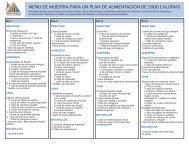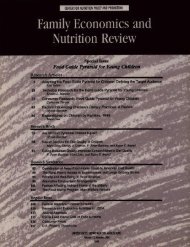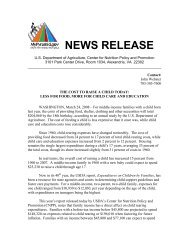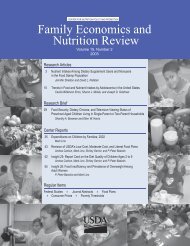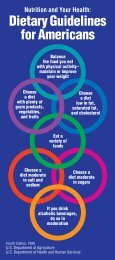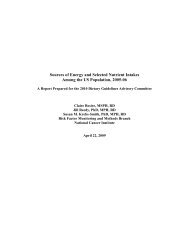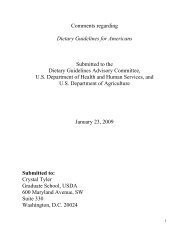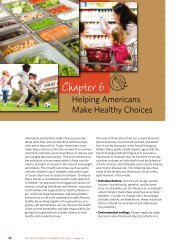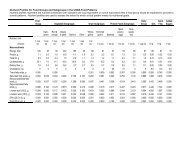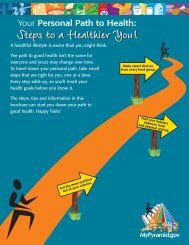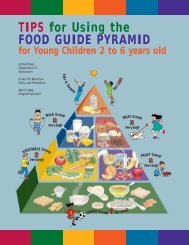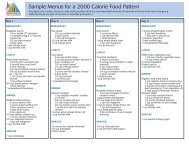Elderly Nutrition - Center for Nutrition Policy and Promotion - US ...
Elderly Nutrition - Center for Nutrition Policy and Promotion - US ...
Elderly Nutrition - Center for Nutrition Policy and Promotion - US ...
Create successful ePaper yourself
Turn your PDF publications into a flip-book with our unique Google optimized e-Paper software.
fiber, niacin, <strong>and</strong> vitamin C than did<br />
White participants (Holahan & Kunkel,<br />
1986).<br />
The purpose of the current pilot study<br />
was to examine the barriers to adequate<br />
calcium intake, through focus group<br />
discussions, among the African-<br />
American elderly population that<br />
participates in the congregate meal<br />
program. The in<strong>for</strong>mation from this<br />
study is needed to prepare effective,<br />
relevant, <strong>and</strong> appropriate nutritional<br />
education presentations <strong>and</strong> materials.<br />
Methods<br />
Participant Recruitment<br />
In the mid-South region of the United<br />
States, researchers recruited participants<br />
from a congregate meal site in a<br />
large urban senior center. Researchers<br />
held a recruitment session during which<br />
they explained the project’s focus, time<br />
commitment, <strong>and</strong> purpose to potential<br />
participants; scheduled participants <strong>for</strong><br />
the focus group sessions; <strong>and</strong> distributed<br />
appointment cards. Upon completing<br />
all focus group sessions, participants<br />
received a $15 gift certificate to<br />
a local grocery store. The researchers<br />
completed the official recruitment<br />
process in 1 day; however, the participants,<br />
without prompting, recruited<br />
others. Only African-American elders<br />
60 years <strong>and</strong> older participated in this<br />
study.<br />
Assessment Instruments<br />
The assessment instruments consisted<br />
of the Demographic <strong>and</strong> Calcium<br />
Intake Questionnaire (DCIQ) (Fleming<br />
& Heimbach, 1994) <strong>and</strong> the focus<br />
group questions (box 1). In addition<br />
to collecting demographic data,<br />
researchers used the DCIQ to assess<br />
participants’ food preferences in<br />
relationship to dairy <strong>and</strong> calciumcontaining<br />
foods. To make the focus<br />
group procedures <strong>and</strong> questions more<br />
reliable <strong>and</strong> while taking into account<br />
the age <strong>and</strong> cultural differences<br />
of elderly African Americans, the<br />
researchers used a dietary calcium<br />
intake questionnaire developed <strong>for</strong><br />
low-income Vietnamese mothers<br />
(Reed, Meeks, Nguyen, Cross, &<br />
Garrison, 1998). For example, where<br />
Reed <strong>and</strong> colleagues emphasized Asian<br />
cultural references, the researchers<br />
substituted African-American cultural<br />
references <strong>and</strong> maintained the theoretical<br />
framework of the original template,<br />
which was based on the PRECEDE-<br />
PROCEED model (Green & Kreuter,<br />
1991). This model has three central<br />
components related directly to the<br />
types of questions raised during a<br />
focus group discussion that seeks to<br />
underst<strong>and</strong> how to address, in a better<br />
fashion, dairy calcium needs through<br />
nutrition education: (1) predisposing<br />
(knowledge, attitudes, <strong>and</strong> motivations),<br />
(2) enabling (resources <strong>and</strong><br />
skills), <strong>and</strong> (3) rein<strong>for</strong>cing (praise <strong>and</strong><br />
perceived benefits). Based on the<br />
recommendations of Krueger (1998),<br />
the researchers interspersed these<br />
questions within the procedural<br />
framework described in box 1.<br />
Procedures <strong>for</strong> Data Collection<br />
<strong>and</strong> Data Analysis<br />
Each of the six focus groups was limited<br />
to no more than 12 participants, <strong>and</strong><br />
each session lasted no longer than 1½<br />
hours. A total of 56 African Americans<br />
participated. At the beginning of each<br />
focus group session, the researchers<br />
obtained a written consent from each<br />
participant. Be<strong>for</strong>e group discussions<br />
began, the researchers administered<br />
the DCIQ to participants <strong>and</strong> offered<br />
assistance if needed. To help participants<br />
become com<strong>for</strong>table, the researchers<br />
asked each to “tell us your<br />
name, <strong>and</strong> tell us what your favorite<br />
food is.” To transition to the discussion,<br />
the researchers asked participants<br />
to talk about some of the good points<br />
about their diet <strong>and</strong> how they would<br />
improve their diet.<br />
Participants considered milk<br />
good <strong>for</strong> bones <strong>and</strong> teeth <strong>and</strong><br />
were concerned about bone<br />
health <strong>and</strong> disease prevention<br />
in spite of being unable to<br />
describe calcium-related<br />
deficiency diseases.<br />
2003 Vol. 15 No. 1 5



